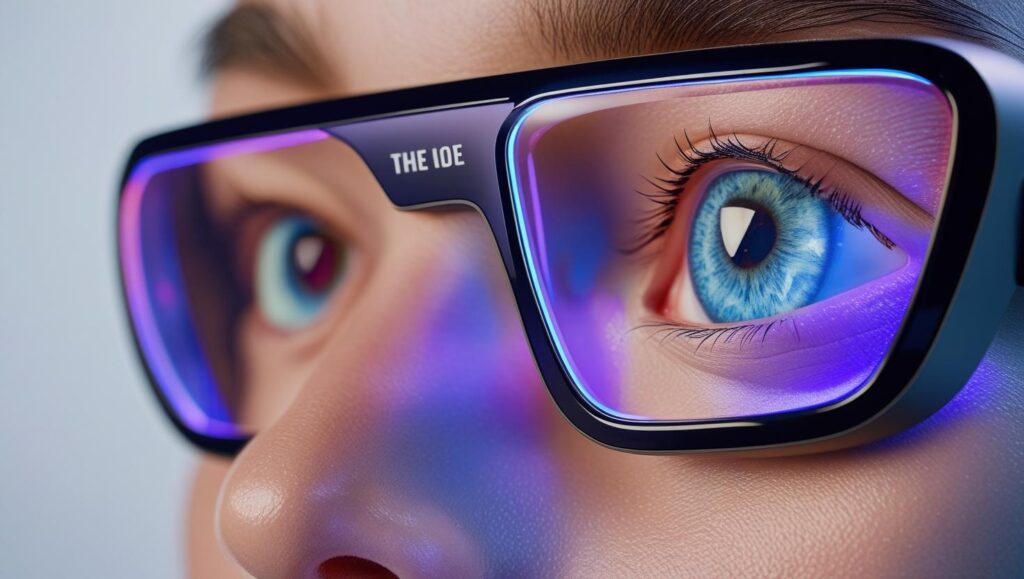The near-eye display industry, encompassing augmented reality (AR), virtual reality (VR), and mixed reality (MR), has witnessed transformative advancements in recent years. At the heart of this evolution lies artificial intelligence (AI), which has redefined how these immersive technologies function and interact with users. The AI Impact on Near-Eye Display Industry is profound, enabling smarter, more intuitive, and visually stunning experiences that push the boundaries of human-computer interaction. From optimizing display rendering to enhancing user interfaces, AI is reshaping the landscape of near-eye displays, making them more accessible and efficient. This article delves into the multifaceted ways AI is revolutionizing this industry, exploring its applications, benefits, challenges, and future potential. By understanding the AI Impact on Near-Eye Display Industry, stakeholders can better navigate the opportunities and innovations driving this dynamic field.
The near-eye display market is projected to grow from USD 2.17 billion in 2025 to USD 6.65 billion in 2030, at a CAGR of 25.1%

Understanding Near-Eye Displays and Their Importance
Near-eye displays are compact, wearable screens positioned close to the eyes, typically integrated into headsets or glasses, to deliver immersive visual experiences. These displays are the cornerstone of AR, VR, and MR technologies, enabling applications in gaming, education, healthcare, and industrial training. The AI Impact on Near-Eye Display Industry is critical because it addresses the inherent challenges of these devices, such as limited processing power, high latency, and the need for seamless user interaction. By leveraging AI algorithms, near-eye displays can achieve higher resolution, lower power consumption, and more natural interfaces, enhancing their practicality and appeal. The synergy between AI and near-eye displays is unlocking new possibilities, making these devices indispensable tools for both consumers and professionals. As the demand for immersive technologies grows, the AI Impact on Near-Eye Display Industry continues to drive innovation, ensuring that these devices meet the evolving needs of users across diverse sectors.
How AI Enhances Visual Rendering in Near-Eye Displays
One of the most significant contributions of the AI Impact on Near-Eye Display Industry is in visual rendering. Rendering high-quality images in near-eye displays requires substantial computational resources, which can strain the limited hardware of wearable devices. AI-powered techniques, such as foveated rendering, optimize this process by focusing computational power on the user’s central field of vision while reducing detail in peripheral areas. This approach, driven by AI algorithms that track eye movements, significantly reduces processing demands without compromising visual quality. Additionally, AI-based upscaling techniques, like deep learning super-resolution, enhance image clarity, allowing near-eye displays to deliver crisp visuals even on lower-resolution screens. The AI Impact on Near-Eye Display Industry in rendering not only improves performance but also extends battery life, making devices more practical for prolonged use. By streamlining complex rendering tasks, AI ensures that near-eye displays provide immersive experiences that are both visually stunning and computationally efficient, setting a new standard for AR and VR applications.
AI-Driven User Interaction and Interface Design
The AI Impact on Near-Eye Display Industry extends beyond visuals to revolutionize user interaction. Traditional input methods, such as controllers or touchpads, can be cumbersome in immersive environments. AI enables more intuitive interfaces through technologies like gesture recognition, voice control, and gaze tracking. For instance, AI algorithms analyze hand movements in real time, allowing users to interact with virtual objects naturally, without physical controllers. Similarly, natural language processing (NLP) powered by AI facilitates voice-driven commands, enabling seamless communication with AR/VR systems. Gaze tracking, another AI-driven innovation, lets users navigate interfaces by simply looking at specific elements, enhancing accessibility and ease of use. The AI Impact on Near-Eye Display Industry in interface design is transformative, as it creates more immersive and user-friendly experiences that cater to diverse audiences. By reducing the learning curve for AR/VR devices, AI-driven interfaces are making near-eye displays more inclusive, paving the way for widespread adoption across industries like education, entertainment, and healthcare.
AI’s Role in Personalization of Near-Eye Display Experiences
Personalization is a key driver of user engagement, and the AI Impact on Near-Eye Display Industry is making it a reality. AI algorithms analyze user behavior, preferences, and contextual data to tailor AR/VR experiences to individual needs. For example, in gaming, AI can adjust difficulty levels or modify environments based on a player’s skill and preferences, creating a more engaging experience. In healthcare, AI-driven near-eye displays can customize visual therapy sessions for patients with specific conditions, such as amblyopia or visual impairments. Retail applications also benefit from AI personalization, as virtual try-on experiences powered by AI adapt to a user’s facial features and style preferences. The AI Impact on Near-Eye Display Industry in personalization enhances user satisfaction and drives adoption by delivering experiences that feel uniquely tailored. By leveraging machine learning to understand user patterns, AI ensures that near-eye displays are not just tools but personalized gateways to immersive worlds, fostering deeper connections between users and technology.
Improving Hardware Efficiency Through AI Integration
Hardware limitations have long been a challenge for near-eye displays, as these devices must balance performance, portability, and battery life. The AI Impact on Near-Eye Display Industry addresses these constraints by optimizing hardware efficiency. AI algorithms manage power consumption by dynamically adjusting processing tasks based on user activity. For instance, when a user is focused on a static virtual scene, AI can reduce refresh rates or lower resolution in less critical areas, conserving energy. Additionally, AI-driven thermal management ensures that devices remain cool during intensive tasks, improving comfort for users. The AI Impact on Near-Eye Display Industry also extends to hardware design, where AI simulations help engineers create more compact and efficient components. By integrating AI into both software and hardware, near-eye displays achieve a delicate balance of performance and practicality, making them viable for everyday use. This optimization is crucial for scaling AR/VR technologies, as it ensures that devices are not only powerful but also user-friendly and sustainable.

AI-Powered Content Creation for Near-Eye Displays
Content is the lifeblood of AR/VR experiences, and the AI Impact on Near-Eye Display Industry is revolutionizing how it is created. AI tools, such as generative adversarial networks (GANs), enable developers to create realistic 3D models, textures, and environments with minimal manual effort. These AI-generated assets reduce development time and costs, allowing creators to focus on crafting compelling narratives. Additionally, AI-driven procedural generation techniques create dynamic virtual worlds that adapt to user actions, ensuring that no two experiences are identical. The AI Impact on Near-Eye Display Industry in content creation also extends to real-time adaptation, where AI modifies content based on user inputs or environmental factors. For example, in training simulations, AI can adjust scenarios to match a trainee’s skill level, providing a more effective learning experience. By automating and enhancing content creation, AI is democratizing access to high-quality AR/VR experiences, enabling smaller studios and independent creators to compete in the near-eye display market.
Addressing Challenges of AI Integration in Near-Eye Displays
While the AI Impact on Near-Eye Display Industry is overwhelmingly positive, it is not without challenges. Integrating AI into near-eye displays requires significant computational resources, which can strain device performance. Additionally, AI algorithms must operate with low latency to maintain immersion, as even slight delays can disrupt the user experience. Privacy concerns also arise, as AI-driven features like gaze tracking and behavior analysis collect sensitive user data. The AI Impact on Near-Eye Display Industry must address these issues through robust encryption, transparent data policies, and efficient AI models that minimize resource demands. Furthermore, ensuring compatibility between AI systems and diverse hardware platforms is critical for scalability. Despite these hurdles, ongoing advancements in edge AI, which processes data locally on devices, are mitigating performance and privacy concerns. By tackling these challenges, the AI Impact on Near-Eye Display Industry can continue to drive innovation while maintaining user trust and satisfaction.
Applications of AI in Near-Eye Displays Across Industries
The AI Impact on Near-Eye Display Industry is evident across a wide range of applications, transforming how industries leverage AR/VR technologies. In healthcare, AI-powered near-eye displays assist surgeons with real-time overlays of patient data during procedures, improving precision and outcomes. In education, AI-driven simulations create interactive learning environments that adapt to students’ progress, enhancing retention and engagement. The gaming industry benefits from AI’s ability to create dynamic, immersive worlds that respond to player actions, elevating entertainment experiences. Industrial sectors, such as manufacturing and logistics, use AI-enhanced near-eye displays for training, maintenance, and remote collaboration, boosting efficiency and reducing costs. The AI Impact on Near-Eye Display Industry also extends to retail, where virtual try-ons and immersive shopping experiences drive consumer engagement. By enabling these diverse applications, AI is positioning near-eye displays as versatile tools that deliver value across sectors, solidifying their role in the future of technology.
The Future Potential of AI in Near-Eye Display Innovation
Looking ahead, the AI Impact on Near-Eye Display Industry promises even greater advancements. Emerging technologies, such as brain-computer interfaces (BCIs), could integrate with AI to enable thought-driven control of near-eye displays, creating seamless human-machine interactions. Advances in AI-driven holography may also lead to more realistic and lightweight displays, reducing the bulkiness of current devices. The AI Impact on Near-Eye Display Industry will likely accelerate the development of fully autonomous AR/VR systems that adapt to users’ environments and needs in real time. Additionally, AI could enable cross-platform compatibility, allowing near-eye displays to integrate with other smart devices for a cohesive ecosystem. As AI continues to evolve, its impact on near-eye displays will drive the creation of more immersive, accessible, and innovative experiences, reshaping how we interact with digital and physical worlds. The future of the AI Impact on Near-Eye Display Industry is bright, with endless possibilities for transforming technology and human experiences.
Embracing the AI Impact on Near-Eye Display Industry
The AI Impact on Near-Eye Display Industry is a game-changer, driving innovation across visual rendering, user interaction, personalization, hardware efficiency, and content creation. By addressing challenges and enabling diverse applications, AI is making near-eye displays more powerful, accessible, and user-friendly. As industries continue to adopt AR/VR technologies, the AI Impact on Near-Eye Display Industry will play a pivotal role in shaping their evolution, delivering experiences that are both immersive and practical. Stakeholders, from developers to consumers, must embrace this transformative force to unlock the full potential of near-eye displays. The future is clear: the AI Impact on Near-Eye Display Industry is not just enhancing technology—it is redefining how we see and interact with the world.
FAQs
What is the AI Impact on Near-Eye Display Industry?
The AI Impact on Near-Eye Display Industry refers to how artificial intelligence enhances AR/VR technologies by improving visual rendering, user interfaces, personalization, and hardware efficiency, driving innovation and adoption.
How does AI improve visual rendering in near-eye displays?
AI optimizes visual rendering through techniques like foveated rendering and deep learning super-resolution, reducing computational demands while enhancing image quality, a key aspect of the AI Impact on Near-Eye Display Industry.
What role does AI play in user interaction for near-eye displays?
AI enables intuitive interfaces via gesture recognition, voice control, and gaze tracking, making AR/VR experiences more accessible and immersive, showcasing the AI Impact on Near-Eye Display Industry.
Can AI personalize AR/VR experiences in near-eye displays?
Yes, AI analyzes user behavior and preferences to tailor content, such as gaming environments or healthcare therapies, enhancing engagement through the AI Impact on Near-Eye Display Industry.
What are the challenges of integrating AI into near-eye displays?
Challenges include high computational demands, latency issues, and privacy concerns, but edge AI and robust data policies are addressing these, supporting the AI Impact on Near-Eye Display Industry.
